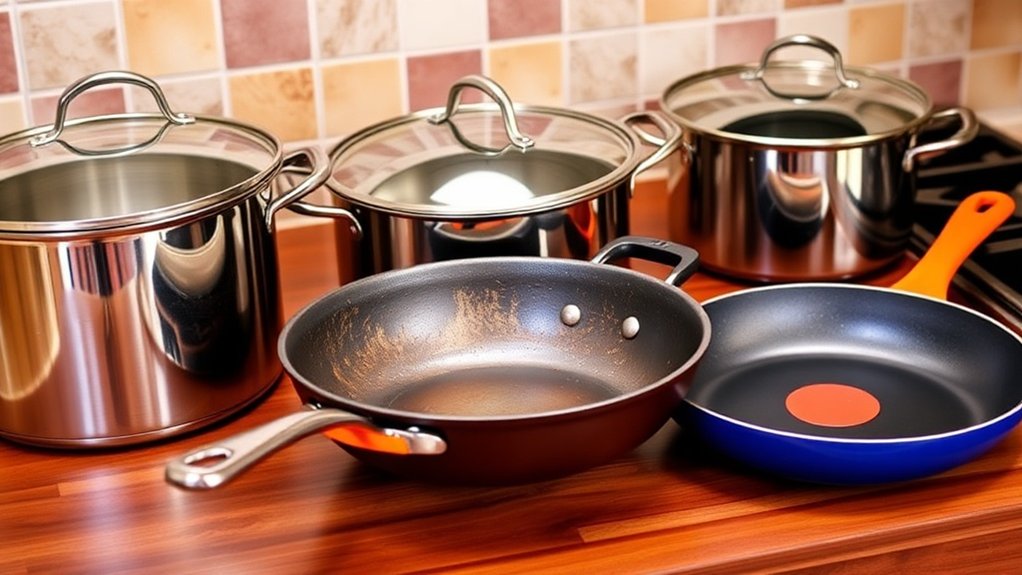Stainless Steel, Cast Iron, or Non-Stick? Choosing the Best Cookware Surface
When selecting cookware, the choice between stainless steel, cast iron, and non-stick surfaces hinges on their unique characteristics. Cast iron excels in heat retention and durability but requires maintenance. Stainless steel offers versatility, corrosion resistance, and ease of cleaning. Non-stick surfaces provide convenience and healthy cooking options, though they may have longevity issues. Each material has advantages and disadvantages, influencing cooking techniques. Exploring these factors further reveals the best option customized to individual cooking needs.
Understanding Cookware Materials
Cookware materials play an essential role in determining cooking performance and suitability for various culinary tasks.
Different materials offer unique advantages and limitations, influencing the choice of cooking techniques. For instance, cast iron excels in heat retention, ideal for slow cooking, while stainless steel provides durability and versatility, accommodating acidic foods without reaction.
Non-stick surfaces simplify cleanup but may compromise longevity due to scratching concerns. Material durability varies greatly; cast iron can withstand decades of use, whereas non-stick may require replacement.
Understanding these attributes is vital for selecting cookware that aligns with individual cooking needs and preferences.
Advantages of Cast Iron Cookware
While many cookware materials offer unique benefits, cast iron stands out due to its exceptional heat retention and versatility.
Cast iron cookware excels in maintaining consistent temperatures, making it ideal for tasks such as braising, searing, and slow cooking. It can be used on various cooktops, including induction, and is suitable for outdoor cooking.
Additionally, cast iron’s durability allows it to last for generations with proper maintenance. Though it requires seasoning to maintain its non-stick properties, the advantages of cast iron with regard to heat retention and cooking performance make it a preferred choice for many culinary enthusiasts.
Benefits of Stainless Steel Cookware
Stainless steel cookware presents a compelling alternative to cast iron, characterized by its durability and versatility.
Its resistance to corrosion and staining, attributed to durability factors like the high chromium and nickel content, guarantees longevity. This material does not react with acidic or alkaline foods, enhancing cooking versatility across a range of dishes.
Additionally, stainless steel is often dishwasher-safe and can tolerate high oven temperatures, making it suitable for various cooking methods.
While it may require proper heating techniques to prevent sticking, the overall maintenance is straightforward, positioning it as a practical choice for both novice and experienced cooks.
The Appeal of Non-Stick Cookware
Non-stick cookware frequently appeals to a wide range of home cooks due to its convenience and ease of use. The non-stick advantages include effortless food release and simplified cleaning, often requiring less fat for cooking. This makes it particularly popular among those seeking healthier meal preparation.
However, non-stick cookware also presents non-stick drawbacks, such as limited durability when exposed to metal utensils and potential health concerns regarding coatings, particularly at high temperatures. Additionally, the necessity for careful storage and handling can deter some buyers.
Ultimately, the choice hinges on balancing these benefits and limitations against individual cooking preferences.
Safety and Maintenance Tips for Cookware
How can cooks guarantee the longevity and safety of their cookware? Implementing effective maintenance practices is essential.
For cast iron, regular seasoning and careful cleaning prevent rust and preserve its non-stick properties.
Stainless steel requires oil to prevent sticking and regular polishing to maintain its appearance.
Non-stick surfaces must be treated gently; using non-metal utensils and avoiding high heat are critical safety precautions to prevent flaking.
Cooks should also regularly inspect all cookware for signs of wear or damage, ensuring that their cooking tools remain safe and efficient for culinary endeavors.
Adhering to these guidelines enhances cookware lifespan and safety.







